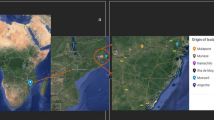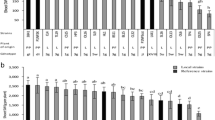Abstract
Native perennial legume Adesmia bicolor reveals characteristics that are key to securing persistence under grazing. Literature on the diversity and symbiotic effectiveness of indigenous rhizobia-nodulating A. bicolor in central Argentina is limited. The purpose of this study was therefore to determine phenotypic and genotypic variability as well as biological N-fixation effectiveness in rhizobia isolated from A. bicolor nodules. To this end, repetitive genomic regions were analyzed using ERIC primers. In the greenhouse, plants were grown under a (i) N-fertilized treatment, (ii) N-free control treatment, and (iii) rhizobia inoculation treatment. Dry weight and N-content were analyzed. All isolates belonged to Rhizobium genus and showed high symbiotic effectiveness. The N-content/subterranean N-content ratio in aerial and subterranean parts of inoculated plants was higher than that observed in N-fertilized plants during the vegetative stage. Results from this study demonstrate that symbiosis between native rhizobial strains and A. bicolor is very effective.




Similar content being viewed by others
References
Abaidoo RC, Keyser HH, Singleton PW, Dashiell KE, Sanginga N (2007) Population size, distribution, and symbiotic characteristics of indigenous Bradyrhizobium spp. that nodulate TGx soybean genotypes in Africa. Appl Soil Ecol 35:57–67
Altschul SF, Madden TL, Schäffer AA, Zhang J, Zhang Z, Miller W, Lipman DJ (1997) Gapped BLAST and PSI-BLAST: a new generation of protein database search programs. Nucleic Acids Res 25:3389–3402
Ardley JK, Parker MA, De Meyer SE, Trengove RD, O’Hara GW, Reeve WD, Yates RJ, Dilworth MJ, Willems A, Howieson JG (2012) Microvirga lupini sp. nov., Microvirga lotononidis sp. nov., and Microvirga zambiensis sp. nov. are Alphaproteobacterial root nodule bacteria that specifically nodulate and fix nitrogen with geographically and taxonomically separate legume hosts. Int J Syst Evol Microbiol. doi:10.1099/ijs.0.035097-0
Bianco CA (2002) Growth forms, taxonomy, distribution, and uses of Adesmia species (Leguminosae) in central Argentina. Cramer J, Sttutgart, Ph.D. thesis
Bianco CA, Kraus TA (2005) Desarrollo y estructura de la semilla y el fruto de A. bicolor (Fabaceae). Phyton 71–77
Binde DR, Menna P, Bangel EV, Barcellos FG, Hungria M (2009) rep-PCR fingerprinting and taxonomy based on the sequencing of the 16S rRNA gene of 54 elite commercial rhizobial strains. Appl Microbiol Biotechnol 83:897–908
Bontemps C, Elliott GN, Simon MF, Dos Reis FB junior, Gross E, Lawton RC, Neto NE, Loureiro MF, De Faria SM, Sprent JI, James EK, Young JPW (2010) Burkholderia species are ancient symbionts of legumes. Mol Ecol 19:44–52
Bremner JM, Mulvaney CS (1982) Nitrogen-total. In: Page AL, Miller RH, Keeney DR (eds) Methods of soil analysis. Part 2. Chemical and microbiological properties, 2nd edn. American Society of Agronomy, Inc. & Soil Science Society of America, Inc. Publishers, Madison, pp 595–624
Buntjer BJ (1999) Software Crosscheck, 8. Wageningen University and Research Center, Wageningen
Carlsson G, Huss-Danell K (2003) Nitrogen fixation in perennial forage legumes in the field. Plant Soil 253:353–372
Coll J, Zarza A (1992) Leguminosas nativas promisorias: trébol polimorfo y babosita. INIA. Boletín de divulgación 22. Editorial Agropecuaria Hemisferio Sur S.R.L. Montevideo, Uruguay, pp 1–19
Coutinho HLC, Oliveira VM, Lovato A, Maia AHN, Manfio GP (1999) Evaluation of the diversity of rhizobia in Brazilian agricultural soils cultivated with soybeans. Appl Soil Ecol 13:159–167
Dodd MB, Orr SJ (1995) Seasonal growth, phosphate response, and drought tolerance of 11 perennial legume species grown in a hill-country soil. NZ J Agric Res 38:7–20
Downie JA (2010) The roles of extracellular proteins, polysaccharides and signals in the interactions of rhizobia with legume roots. FEMS Microbiol Rev 34:150–170
Duodu S, Carlsson G, Huss-Danell K, Svenning MM (2007) Large genotypic variation but small variation in N2 fixation among rhizobia nodulating red clover in soils of northern Scandinavia. J Appl Microbiol 102:1625–1635
Edwards U, Rogall T, Blöcker H, Emde M, Böttger EC (1989) Isolation and direct complete nucleotide determination of entire genes. Characterization of a gene coding for 16S ribosomal RNA. Nucleic Acids Res 17:7843–7853
Hall TA (1999) BioEdit: a user-friendly biological sequence alignment editor and analysis program for Windows 95/98/NT. Nucleic Acids Symp Ser 41:95–98
Jørgensen FV, Ledgard SF (1997) Contributions from stolons and roots to estimates of the total amount of N2 fixed by white clover (Trifolium repens L.). Ann Bot 80:641–648
Kato Y, Asahara M, Goto K, Kasai H, Yokota A (2008) Methylobacterium persicinum sp. nov., Methylobacterium komagatae sp. nov., Methylobacterium brachiatum sp. nov., Methylobacterium tardum sp. nov. and Methylobacterium gregans sp. nov., isolated from freshwater. Int J Syst Evol Microbiol 58:1134–1141
Lavin M, Pennington RT, Klitgaard BB, Sprent JI, De Lima HC, Gasson PE (2001) The dalbergioid legumes (Fabaceae): delimitation of a pantropical monophyletical clade. Am J Bot 88:503–533
Lindemann WC, Glover CR (2003) Nitrogen fixation by legumes. Guide A-129. Cooperative Extension Service, College of Agriculture and Home Economics. New Mexico State University
Lindström K, Murwira M, Willems A, Altier N (2010) The biodiversity of beneficial microbe-host mutualism: the case of rhizobia. Res Microbiol 161:453–463
Liu XY, Wang ET, Li Y, Chen WX (2007) Diverse bacteria isolated from root nodules of Trifolium, Crotalaria and Mimosa grown in the subtropical regions of China. Arch Microbiol 188:1–14
Mantelin S, Fischer-Le Saux M, Zakhia F, Béna G, Bonneau S, Jeder H, de Lajudie P, Cleyet-Marel JC (2006) Emended description of the genus Phyllobacterium and description of four novel species associated with plant roots: Phyllobacterium bourgognense sp. nov., Phyllobacterium ifriqiyense sp. nov., Phyllobacterium leguminum sp. nov. and Phyllobacterium brassicacearum sp. nov. Int J Syst Evol Microbiol 56:827
Masson-Boivin C, Giraud E, Perret X, Batut J (2009) Establishing nitrogen-fixing symbiosis with legumes: how many Rhizobium recipes? Trends Microbiol 17:458–466
Oke V, Long SR (1999) Bacteroid formation in the Rhizobium–legume symbiosis. Curr Opin Microbiol 2:641–646
Philipson MN, Blair ID (1957) Bacteria in clover root tissue. Can J Microbiol 3:125–129
Ramos J, Bisseling T (2004) Symbiotic nitrogen fixation. In: Amâncio S, Stulen I (eds) Nitrogen acquisition and assimilation in higher plants. Kluwer Academic Publishers, Dordrecht, pp 99–132
Requena N, Perez-Solis E, Azcón-Aguilar C, Jeffries P, Barea JM (2001) Management of indigenous plant–microbe symbioses aids restoration of desertified ecosystems. Appl Environ Microbiol 67:495–498
Sato Y, Nishihara H, Yoshida M, Watanabe M, Rondal JD, Concepcion RN, Ohta H (2006) Cupriavidus pinatubonensis sp. nov. and Cupriavidus laharis sp. nov., novel hydrogen-oxidizing, facultatively chemolithotrophic bacteria isolated from volcanic mudflow deposits from Mt. Pinatubo in the Philippines. Int J Syst Evol Microbiol 56:973–978
Scheffer-Basso SM, Carneiro CM, Voss M (2000) Nodulação e fixação biológica de nitrogênio em Adesmia araujoi Burk. Rev Bras Agroc 6:16–18
Scheffer-Basso SM, Voss M, Ávila Jacques AV (2001) Nodulação e fixação biológica de nitrogênio de Adesmia latifolia e Lotus corniculatus em vasos de Leonard. Rev Bras Zoot 30:687–693
Schlüter PM, Harris SA (2006) Analysis of multilocus fingerprinting data sets containing missing data. Mol Ecol Notes 6:569–572
Shannon CE, Weaver W (1949) The mathematical theory of communication. University of Illinois Press, Urbana
Sprent JI (2009) Legume nodulation: a global perspective. Wiley-Blackwell, Oxford
Sprent JI, Gehlot HS (2010) Nodulated legumes in arid and semi-arid environments: are they important? Plant Ecol Div 3:211–219
Sturz AV, Carter MR, Johnston HW (1997) A review of plant disease, pathogen interactions and microbial antagonism under conservation tillage in temperate humid agriculture. Soil Till Res 41:169–189
Tamura K, Dudley J, Nei M, Kumar S (2007) MEGA4: molecular evolutionary genetics analysis (MEGA) software version 4.0. Mol Biol Evol 24:1596–1599
Taurian T, Aguilar OM, Fabra A (2002) Characterization of nodulating peanut rhizobia isolated from a native soil population in Córdoba, Argentina. Symbiosis 25:49–53
Taurian T, Ibáñez F, Fabra A, Aguilar OM (2006) Genetic diversity of rhizobia nodulating Arachis hypogaea L. in central Argentinean soils. Plant Soil 282:41–52
van Berkum P, Eardly BD (2002) The aquatic budding bacterium Blastobacter denitrificans is a nitrogen-fixing symbiont of Aeschynomene indica. Appl Environ Microbiol 68:1132–1136
Verma M, Kumar M, Dadhwal M, Kaur J, Lal R (2009) Devosia albogilva sp. nov. and Devosia crocina sp. nov., isolated from a hexachlorocyclohexane dump site. Int J Syst Evol Microbiol 59:795–799
Versalovic J, Schneider M, de Bruijn FJ, Lupski JR (1994) Genomic fingerprinting of bacteria using repetitive sequence-based polymerase chain reaction. Meth Mol Cell Biol 5:25–40
Vileta D, Bianco L, Grosso M, Malpassi R (2010) Biological nitrogen fixation by A. bicolor and A. macrostachya, potential forage species for arid and semi-arid environments. Interciencia 35:120–125
Vincent JM (1970) A manual for the practical study of root nodule bacteria. IBP Handbook N° 15. Blackwell, Oxford
Vlassak KM, Vanderleyden J (1997) Factors influencing nodule occupancy by inoculant rhizobia. Critical Rev Plant Sci 16:163–229
Walsh PS, Metzger DA, Higuchi R (1991) Chelex 100 as a medium for simple extraction of DNA for PCR-based typing from forensic material. Biotechniques 10:506–513
Wang H, Man CX, Wang ET, Chen WX (2009) Diversity of rhizobia and interactions among the host legumes and rhizobial genotypes in an agricultural-forestry ecosystem. Plant Soil 314:169–182
Weaver RW, Frederick LR (1982) Rhizobium. In: Page AL, Miller RH, Keeney DR (eds) Methods of soil analysis. Part 2. Chemical and microbiological properties, 2nd edn. American Society of Agronomy, Inc. & Soil Science Society of America, Inc. Publishers, Madison, pp 1043–1070
Weberling F, Kraus TA, Bianco CA, Malpassi R (2002) Variación y estrategias adaptativas de los sistemas de ramificación de Fabáceas herbáceas. Feddes Repert 113:342–353
Wei GH, Zhang ZX, Chen C, Chen WM, Ju WT (2007) Phenotypic and genetic diversity of rhizobia isolated from nodules of the legume genera Astragalus, Lespedeza and Hedysarum in northwestern China. Microbiol Res 163:651–662
Weir BS (2012) The current taxonomy of rhizobia. NZ rhizobia website. http://www.rhizobia.co.nz/taxonomy/rhizobia.html. Last updated 10 April 2012
Weon HY, Kim BY, Joa JH, Son JA, Song MH, Kwon SW, Go SJ, Yoon SH (2008) Methylobacterium iners sp. nov. and Methylobacterium aerolatum sp. nov., isolated from air samples in Korea. Int J Syst Evol Microbiol 58:93–96
Westphal Muniz A, Dalla Costa M, Wolff CL, Faria de Oliveira WA, Saccol de Sá E (2012) Seleção de estirpes de rizóbio para Adesmia latifolia (Spreng.) Vogel. Biotemas 25:177–180
Zahran HH (2001) Rhizobia from wild legumes: diversity, taxonomy, ecology, nitrogen fixation and biotechnology. J Biotechnol 91:143–153
Zakhia F, Jeder H, Domergue O, Willems A, Cleyet-Marel JC, Gillis M, Dreyfus B, de Lajudie P (2004) Characterisation of wild legume nodulating bacteria (LNB) in the infra-arid zone of Tunisia. System Appl Microbiol 27:380–395
Zurdo-Piñeiro JL, Rivas R, Trujillo ME, Vizcaíno N, Carrasco JA, Chamber M, Palomares A, Mateos PF, Martínez-Molina E, Velásquez E (2007) Ochrobactrum cytisi sp. nov., isolated from nodules of Cytisus scoparius in Spain. Int J Syst Evol Microbiol 57:784–788
Author information
Authors and Affiliations
Corresponding author
Rights and permissions
About this article
Cite this article
Bianco, L., Angelini, J., Fabra, A. et al. Diversity and Symbiotic Effectiveness of Indigenous Rhizobia-Nodulating Adesmia bicolor in Soils of Central Argentina. Curr Microbiol 66, 174–184 (2013). https://doi.org/10.1007/s00284-012-0260-y
Received:
Accepted:
Published:
Issue Date:
DOI: https://doi.org/10.1007/s00284-012-0260-y




